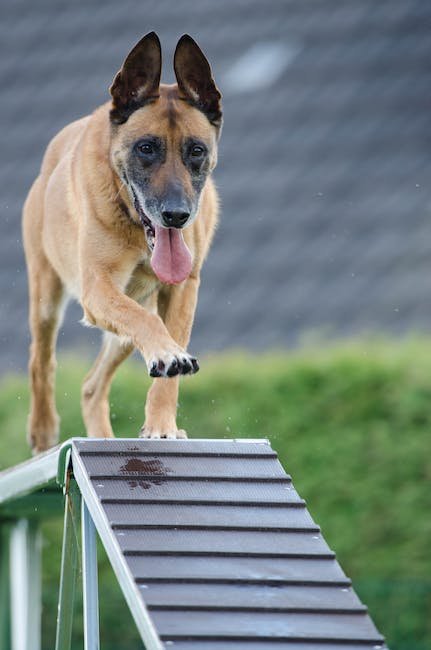Imagine a world where misbehaving dogs could be transformed into well-mannered canines with nothing more than a few magical tricks and a flick of a wand. While this may remain confined to the realms of fiction, the realm of dog training has its own enchantment - the power of positive reinforcement. As any seasoned dog owner knows, training Fido can be a frustrating endeavor, but it doesn’t have to be. Understanding the importance of context in dog training unveils a world where rewards are the currency of success, and where relationships between humans and their four-legged companions are strengthened through teamwork and understanding. So, grab your treat pouch, don your training cap, and embark on a journey to discover why context truly matters in the enchanting realm of dog training.
Table of Contents
- Setting the Stage: Understanding the Importance of Context in Dog Training
- The Power of Positive Reinforcement Techniques in Shaping Behavior
- Tailoring Training Methods to Individual Dogs: Considering Contextual Factors
- Teaching Tricks and Commands: Specific Recommendations for Successful Positive Reinforcement Training
- Creating an Enriching Environment: Contextual Strategies to Enhance Learning and Behavior
- Q&A
- Final Thoughts

Setting the Stage: Understanding the Importance of Context in Dog Training
When it comes to dog training, context matters. The environment, the dog’s previous experiences, and the specific situation all play a crucial role in shaping a dog’s behavior. Understanding the importance of context allows trainers to effectively address behavioral issues and set their furry companions up for success.
Why is context important?
- Relevance: Each dog is unique, and what may work for one may not be suitable for another. Context helps trainers tailor their approach to each individual dog, taking into account their breed, temperament, and past experiences.
- Understanding triggers: Dogs often exhibit certain behaviors due to specific triggers. By analyzing the context in which these behaviors occur, trainers can identify what triggers certain responses, providing valuable insights for intervention and behavior modification.
- Consistency: Dogs thrive on routine and predictability. By considering the context in which training takes place, trainers can maintain consistency and create an environment that fosters learning and trust.
So, whether you’re training your own dog or seeking professional help, always remember that understanding the importance of context is pivotal. It sets the stage for effective training and lays the foundation for a strong bond between you and your furry companion.

The Power of Positive Reinforcement Techniques in Shaping Behavior
Discover the incredible impact of positive reinforcement techniques in shaping behavior like never before. By understanding the science behind reinforcement, we can unlock the potential to create lasting change and foster a positive environment for growth and development.
Positive reinforcement is a powerful tool that relies on rewarding desired behaviors rather than punishing undesired ones. It reinforces and strengthens the likelihood of a behavior being repeated by offering incentives or rewards that individuals find motivating. Unlike traditional punishment-based approaches, positive reinforcement focuses on nurturing positive habits and encouraging individuals to reach their full potential.
- Increased motivation: Positive reinforcement helps to increase motivation levels by immediately rewarding desired actions. It fuels individuals with a sense of accomplishment and encourages them to continue displaying the desired behavior.
- Enhanced self-esteem: By acknowledging and appreciating positive actions, positive reinforcement elevates an individual’s self-esteem. This, in turn, leads to improved self-confidence, increased self-worth, and a greater sense of belonging.
- Effective learning: Positive reinforcement techniques have shown to be highly effective in educational settings. It promotes a positive classroom environment, improves focus and attention, and fosters a love for learning.
Embrace the power of positive reinforcement techniques and witness a transformation in behavior like never before. Remember, a little positivity goes a long way!

Tailoring Training Methods to Individual Dogs: Considering Contextual Factors
In the world of dog training, one size does not fit all. Each dog is unique, not only in terms of breed and temperament but also in their individual learning style and environmental context. When tailoring training methods to individual dogs, it is crucial to consider various contextual factors that can significantly impact the effectiveness of the training process.
Environmental Factors:
- Physical Surroundings: The physical environment plays a crucial role in dog training. Consider whether the training will take place indoors or outdoors, in a quiet or noisy space, or in a familiar or unfamiliar setting. These factors can affect a dog’s ability to focus and respond to commands.
- Social Context: Dogs are social creatures, and their behavior can be influenced by the presence of other animals, people, or distractions in the environment. Acknowledging and managing these social factors ensures a conducive learning environment for your furry friend.
Individual Factors:
- Learning Style: Dogs have different learning styles, just like humans. Some may respond better to visual cues, while others may rely more on auditory or kinesthetic stimulation. Understanding your dog’s unique learning style allows you to tailor training methods that resonate best with them.
- Personality Traits: Each dog has its own personality, which can greatly influence their responsiveness to training. Whether your dog is confident, shy, energetic, or laid-back, it is essential to adapt your training techniques to their individual traits, taking into account their strengths and weaknesses.
By considering the contextual factors surrounding your individual dog, you can create a customized training plan that maximizes their potential for success. Remember, effective dog training is not a one-size-fits-all approach, but rather an art that embraces the uniqueness of each canine companion.

Teaching Tricks and Commands: Specific Recommendations for Successful Positive Reinforcement Training
When it comes to teaching tricks and commands to your furry friend, positive reinforcement training is the way to go. This method not only strengthens the bond between you and your pet but also encourages good behavior by rewarding their efforts. Here are some specific recommendations for successful positive reinforcement training:
- Start with the basics: Begin by teaching your dog simple commands like sit, stay, and come. These are the building blocks for more complex tricks and behaviors.
- Use rewards: Positive reinforcement relies on rewards to reinforce desired behavior. Treats, praise, and affectionate gestures work wonders in motivating your pet.
- Be consistent: Consistency is key in training. Use the same command words and hand signals every time you want your dog to perform a specific action. This will help them understand what is expected of them.
- Break it down: Break down complex tricks into smaller steps. This allows your dog to learn and progress gradually, making the training process more manageable.
- Keep training sessions short and fun: Dogs have short attention spans, so keep your training sessions brief and engaging. Make it a positive and enjoyable experience for both of you.
Remember, positive reinforcement training is all about rewarding good behavior rather than punishing mistakes. With patience, consistency, and these recommendations, you and your furry companion will be sure to master an array of tricks and commands!
Creating an Enriching Environment: Contextual Strategies to Enhance Learning and Behavior
Transforming Spaces for Optimal Learning:
In order to enhance the learning experience and promote positive behavior, it is essential to create an enriching environment that engages learners and provides them with the necessary tools for success. By taking a contextual approach, educators can transform mundane spaces into vibrant and inspiring learning zones. Consider incorporating flexible seating arrangements that enable collaboration, providing a variety of learning materials and resources, and utilizing technology to facilitate interactive and dynamic lessons. Furthermore, organizing the physical environment to support different learning styles and preferences can greatly contribute to an inclusive and stimulating atmosphere.
Fostering a Sense of Belonging:
Ensuring learners feel valued, supported, and connected is crucial for optimal learning and behavior. Consider implementing strategies that foster a sense of belonging among students, such as establishing inclusive classroom norms and rituals. Encourage peer-to-peer collaboration and provide opportunities for students to actively participate in decision-making processes. Building positive relationships and providing consistent feedback and recognition not only boosts motivation but also creates a safe and trusting environment where students can thrive academically and socially.
Nurturing a Growth Mindset:
By cultivating a growth mindset in learners, educators can empower them to embrace challenges, persist in the face of setbacks, and strive for continuous improvement. Encourage students to view mistakes as opportunities for learning and emphasize the importance of effort and perseverance. Incorporate reflective activities that promote self-awareness and goal-setting, and provide constructive feedback that focuses on strengths and areas for growth. By nurturing a growth mindset, students develop resilience, enhance their problem-solving skills, and become self-directed learners prepared for lifelong success.
- Transforming Spaces for Optimal Learning
- Fostering a Sense of Belonging
- Nurturing a Growth Mindset
Q&A
What is the significance of context in dog training?
Context is crucial in dog training as it influences a dog’s behavior and understanding of commands. Different environments, distractions, and situations can impact a dog’s ability to respond to training consistently.
How does positive reinforcement help in dog training?
Positive reinforcement is a powerful tool in dog training, as it rewards desired behaviors with treats, praise, or play. This method helps dogs associate good behavior with positive outcomes, making them more likely to repeat those behaviors in the future.
Why is it important to understand a dog’s individual needs and preferences?
Understanding a dog’s individual needs and preferences allows trainers to tailor their approach to suit the specific dog. Every dog is unique, and by accommodating their preferences, trainers can create a more positive and successful training experience.
Does punishment have a place in dog training?
While punishment may seem tempting, it can have negative consequences in dog training. It can damage the trust and relationship between a dog and its owner, leading to fear and anxiety. Positive reinforcement offers a more effective and humane alternative.
How can the training environment impact a dog’s behavior?
The training environment greatly influences a dog’s behavior. Different locations, noises, or distractions may affect a dog’s focus and responsiveness to training cues. Gradually exposing dogs to various environments can help generalize their training and improve their obedience in different contexts.
Is consistency important in dog training?
Consistency is vital in dog training to establish clear expectations and boundaries. Dogs thrive on routine and predictability, so providing consistent cues, rewards, and consequences helps them understand what is expected of them and reinforces desired behaviors.
What are some common mistakes to avoid in positive reinforcement training?
Common mistakes in positive reinforcement training include inconsistent rewards, using poorly timed rewards, or inadvertently reinforcing undesired behaviors. It is essential to be clear and consistent in rewarding only the behaviors that are being targeted for reinforcement.
Can dogs of all ages benefit from positive reinforcement training?
Absolutely! Dogs of all ages, from puppies to seniors, can benefit from positive reinforcement training. By using rewards and positive reinforcement techniques, owners can teach dogs new behaviors, modify existing ones, and strengthen their bond with their furry companions.
Final Thoughts
As we close the final chapter of this positive reinforcement guide, it becomes evident that when it comes to dog training, context truly matters. Like pieces in a complex puzzle, each scenario and circumstance mold our furry friends into the well-behaved companions we desire. Whether teaching basic commands, overcoming behavioral challenges, or strengthening the bond we share with our four-legged pals, understanding the power of context can make all the difference.
Throughout this journey, we have explored the fundamental principles of positive reinforcement training and its remarkable impact on our canine companions. With an array of effective techniques and tools at our disposal, we have witnessed firsthand how love, patience, and understanding can transform even the most boisterous of pups into obedient and happy-go-lucky partners.
Yet, in a world brimming with diverse personalities, environments, and stimuli, we have come to realize that a one-size-fits-all approach simply doesn’t exist in the realm of dog training. Every dog possesses their unique temperament, past experiences, and individual needs. It is within the contextual nuances that we unearth the secrets to successful training.
Just as humans thrive in tailored surroundings, our beloved canines also benefit from context-specific strategies. A timid rescue pup may require extra compassion and gradual exposure to new situations, while a high-energy working breed thrives on mental stimulation and physical challenges. By keenly observing and adapting to the context at hand, we unlock the vast potential within our dogs, allowing their true personalities to shine through.
The power of context extends beyond the immediate training sessions. We must consider the broader setting within which our dogs interact, the influence of their surroundings, and the role we play in shaping their behavior. Recognizing the interplay between context and training is not a simple task, but it is a rewarding one.
So, as we bid farewell to this guide, armed with the knowledge that context matters, let us embark upon the remarkable journey of dog training with open hearts and flexible minds. May we embrace the diversity of situations that challenge us, for within these learning opportunities lies the true artistry of positive reinforcement. Together, let us create a harmonious world where dogs and their humans thrive, bonded by love, compassion, and an ever-present understanding of our canine counterparts.
As an affiliate, my content may feature links to products I personally use and recommend. By taking action, like subscribing or making a purchase, you’ll be supporting my work and fueling my taco cravings at the same time. Win-win, right?
Want to read more? Check out our Affiliate Disclosure page.